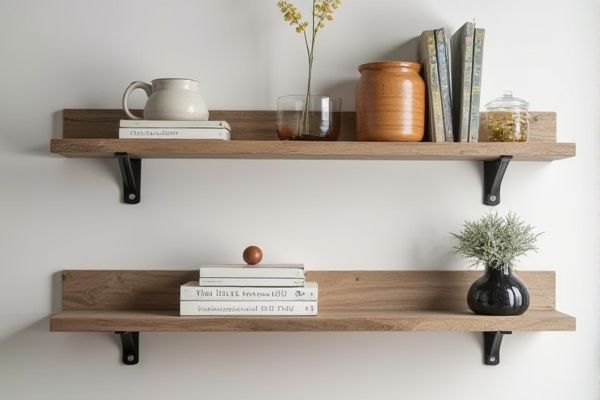
Shelf brackets offer sturdy support for heavy loads and allow customizable shelf height, while shelf pins provide a minimalist look with adjustable positioning but are generally best for lighter items. Discover which option suits your needs and how to choose the right support for Your shelving project by reading the rest of the article.
Table of Comparison
| Feature | Shelf Brackets | Shelf Pins |
|---|---|---|
| Support Type | External, visible under the shelf | Internal, hidden inside the cabinet or shelving unit |
| Load Capacity | High; supports heavy shelves and items | Moderate; designed for lighter shelves and loads |
| Installation | Requires wall or surface mounting with screws | Inserted into pre-drilled holes; no screws needed |
| Adjustability | Fixed position after installation | Highly adjustable; can move shelf height easily |
| Aesthetic Impact | Visible hardware can affect shelf appearance | Minimal visual impact; creates cleaner look |
| Best Use Case | Heavy-duty shelving in garages, workshops, or industrial settings | Light to medium shelving in cabinets, closets, or furniture |
| Material Options | Metal, steel, sometimes wood or plastic | Metal or plastic pins |
| Cost | Generally more expensive due to material and installation | Usually low cost and easy replacement |
Introduction to Shelf Brackets and Shelf Pins
Shelf brackets provide sturdy, visible support for heavier loads and add a decorative element to your shelving, typically made from metal or wood for durability. Shelf pins are small, discreet metal or plastic pegs that fit into pre-drilled holes in the shelving unit, offering adjustable support for lighter items. Choosing between shelf brackets and shelf pins depends on the weight of your items and the desired aesthetic for your space.
What Are Shelf Brackets?
Shelf brackets are sturdy metal or wooden supports designed to hold shelves securely against walls, providing strong load-bearing capacity for heavy items like books or tools. Unlike shelf pins, which fit into predetermined holes inside cabinets for adjustable shelving, shelf brackets are typically mounted externally, enhancing both strength and aesthetic appeal for open shelving. Your choice between shelf brackets and pins depends on the weight of items to be stored and the desired shelf visibility and stability.
What Are Shelf Pins?
Shelf pins are small metal or plastic pegs inserted into pre-drilled holes along cabinet or shelving units to support adjustable shelves. They provide flexibility in shelf placement, allowing users to customize shelf height easily without permanent fixtures. Unlike shelf brackets, shelf pins are typically inconspicuous and designed for light to moderate weight support in furniture and cabinetry.
Key Differences Between Shelf Brackets and Shelf Pins
Shelf brackets provide strong, visible support for heavy loads and are typically mounted externally under the shelf, while shelf pins are small, hidden supports inserted directly into pre-drilled holes inside shelving units for lighter loads. Shelf brackets offer more adjustability in shelf positioning and are better suited for open shelving, whereas shelf pins allow for a cleaner, minimalist look ideal for enclosed cabinets. Your choice depends on the weight capacity needed and the desired aesthetic for your storage solution.
Pros and Cons of Shelf Brackets
Shelf brackets offer robust support and can hold heavier loads, making them ideal for storing bulky items or heavy books. However, they are more visually intrusive compared to shelf pins, which provide a minimalist look and easier adjustability but support less weight. Your choice depends on balancing aesthetic preferences with the required strength and stability for your shelving needs.
Pros and Cons of Shelf Pins
Shelf pins provide a sleek, minimalist look and allow for adjustable shelf heights, making them ideal for customizable storage solutions. Your shelves rest securely on these small, discreet supports, but they may not support as much weight as heavy-duty shelf brackets, limiting their use in holding very heavy items. Shelf pins are easy to install and inexpensive, though their smaller size can make them less durable in high-load applications compared to robust metal shelf brackets.
Load Capacity: Brackets vs. Pins
Shelf brackets typically offer higher load capacity compared to shelf pins, making them ideal for heavier items or larger shelving units. While shelf pins support moderate weight and provide a clean, adjustable solution for lighter loads, brackets distribute weight more effectively across walls, enhancing stability. Your choice should depend on the expected load and the type of shelving you plan to install.
Installation Process Comparison
Shelf brackets require drilling and securing heavy-duty screws into wall studs or anchors, ensuring strong support for heavy loads, whereas shelf pins are inserted into pre-drilled holes within the shelving unit, allowing for easy adjustment and repositioning of the shelves. The installation of shelf brackets demands precise measurement for alignment and typically involves tools like a drill, level, and stud finder. Shelf pins offer a tool-free or minimal tool installation, making them ideal for modular or frequently reconfigured shelving systems.
Best Applications for Shelf Brackets and Shelf Pins
Shelf brackets are ideal for heavy-duty applications requiring strong support, such as holding up wooden or metal shelves in garages, kitchens, or workshops where load-bearing capacity is essential. Shelf pins work best for adjustable shelving systems within cabinets or closets, providing flexibility to rearrange shelf heights without tools. Choosing between the two depends on whether you need permanent, sturdy support or customizable shelving options.
Choosing the Right Support: Final Considerations
When choosing between shelf brackets and shelf pins, factors such as load capacity, aesthetic preferences, and installation complexity play crucial roles. Shelf brackets offer robust support for heavy or bulky items, while shelf pins provide a minimalist, adjustable solution ideal for lighter loads and frequent shelf repositioning. Evaluate the shelf material, desired weight capacity, and visual impact to ensure the right support system enhances both functionality and style.
 homyna.com
homyna.com